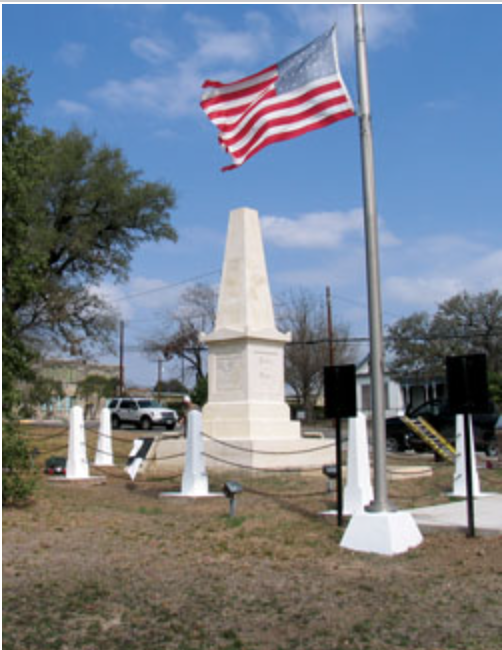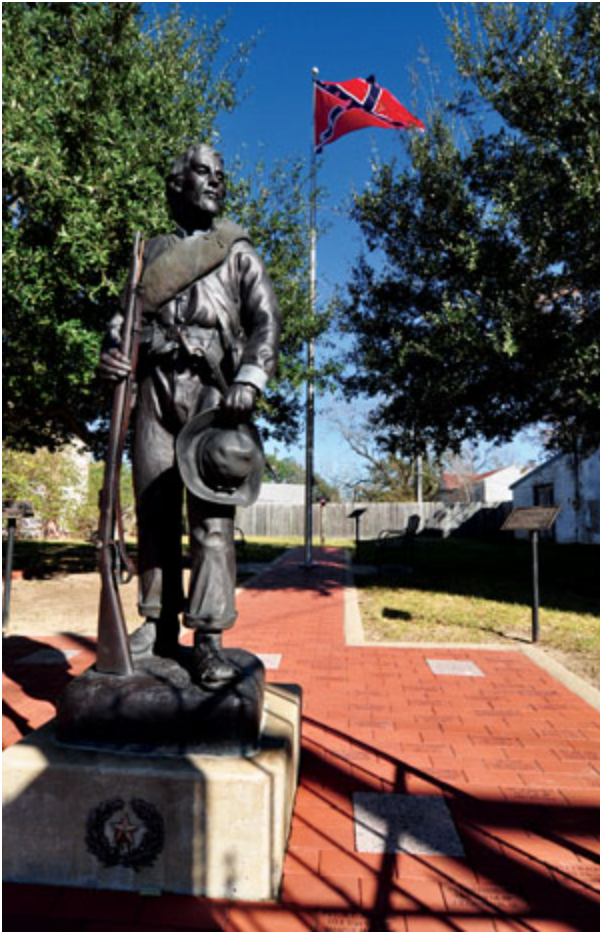Texas’ population almost tripled in the decade between 1850 and 1860, when 604,215 people were counted, including 182,921 slaves. Many of these new settlers came from the Lower South, a region familiar with slavery. Although three-quarters of the Texas population and two-thirds of the farmers did not own slaves, slaveowners controlled 60 to 70 percent of the wealth of the state and dominated the politics.
In 1850, 41 percent of the state’s officeholders were from the slaveholding class; a decade later, more than 50 percent of the officeholders had slaves.
In addition to the political power of the slaveholders, they also provided role models for new immigrants to the state. After these newcomers got their first land, they saw slave ownership as another step up the economic ladder, whether they owned slaves or not. Slave ownership was an economic goal.
This attitude prevailed even in areas of Texas where slaveholding was not widespread or even practical. These factors were the wind that fanned the flames of the secessionist movement throughout the late 1850s.
The appearance of the Know-Nothing Party, which based its platform on a pro-American, anti-immigrant foundation, began to move Texas toward party politics. Because of the large number of foreign-born settlers, the party attracted many Anglo voters. In 1854, the Know-Nothings elected candidates to city offices in San Antonio, and a year later, the mayor of Galveston was elected with the party’s backing. Also in 1855, the Know-Nothings elected 20 representatives and five senators to the Legislature.
The successes spurred the Democrats to serious party organization for the first time. In 1857, Hardin Runnels was nominated for governor at the Democratic convention held in Waco. Sam Houston sought the governorship as an independent, but he also got Know-Nothing backing. Democrats were organized, however, and Houston was dealt the only election defeat in his political career.
Runnels was a strong states’-rights Democrat who irritated many Texans during his administration by advocating reopening the slave trade. His popularity on the frontier also dropped when Indian raids became more severe.
Most Texans still were ambivalent about secession. The Union was seen as a protector of physical and economic stability. No threats to person or property were perceived in remaining attached to the United States.
In 1859, Houston again challenged Runnels, basing his campaign on Unionism. Combined with Houston’s personal popularity, his position on the secession issue apparently satisfied most voters, for they gave him a solid victory over the more radical Runnels. In addition, Unionists A.J. Hamilton and John H. Reagan won the state’s two congressional seats. Texans gave the states’-rights Democrats a sound whipping at the polls.
Within a few months, however, events were to change radically the political atmosphere of the state. On the frontier, the army could not control Indian raids, and with the later refusal of a Republican-controlled Congress to provide essential aid in fighting Indians, the federal government fell into disrepute.
Secessionists played on the growing distrust. Then in the summer of 1860, a series of fires in the cities around the state aroused fears that an abolitionist plot was afoot and that a slave uprising might be at hand — a traditional concern in a slaveholding society.
Vigilantes lynched blacks and Northerners across Texas, and a siege mentality developed.
When Abraham Lincoln was elected president (he was not on the ballot in Texas), secessionists went to work in earnest.
Pleas were made to Gov. Houston to call the Legislature into session to consider secession. Houston refused, hoping the passions would cool. They did not. Finally, Oran M. Roberts and other secessionist leaders issued a call to the counties to hold elections and send delegates to a convention in Austin. Ninety-two of 122 counties responded, and on Jan. 28, 1861, the meeting convened.
Only eight delegates voted against secession, while 166 supported it. An election was called for Feb. 23, 1861, and the ensuing campaign was marked by intolerance and violence. Opponents of secession were often intimidated — except the governor, who courageously stumped the state opposing withdrawal from the Union. Houston also argued that if Texas did secede it should revert to its status as an independent republic and not join the Confederacy.
Only one-fourth of the state’s population had been in Texas during the days of independence, and the argument carried no weight. On election day, 76 percent of 61,000 voters favored secession.
President Lincoln, who took office within a couple of weeks, reportedly sent the Texas governor a letter offering 50,000 federal troops to keep Texas in the Union. But after a meeting with other Unionists, Houston declined the offer. “I love Texas too well to bring strife and bloodshed upon her,” the governor declared. On March 16, Houston refused to take an oath of loyalty to the Confederacy and was replaced in office by Lt. Gov. Edward Clark.
Civil War
Texas did not suffer the devastation of its Southern colleagues in the Civil War. On but a few occasions did Union troops occupy territory in Texas, except in the El Paso area.
The state’s cotton was important to the Confederate war effort because it could be transported from Gulf ports when other Southern shipping lanes were blockaded.
Some goods became difficult to buy, but unlike other states of the Confederacy, Texas still received consumer goods because of the trade that was carried on through Mexico during the war.
Although accurate figures are not available, historians estimate that between 70,000 and 90,000 Texans fought for the South, and between 2,000 and 3,000, including some former slaves, saw service in the Union army.
Texans became disenchanted with the Confederate government early in the war. State taxes were levied for the first time since the Compromise of 1850, and by war’s end, the Confederacy had collected more than $37 million from the state.
But most of the complaints about the government centered on Brig. Gen. Paul O. Hebert, the Confederate commander of the Department of Texas.
In April 1862, Gen. Hebert declared martial law without notifying state officials. Opposition to the South’s new conscription law, which exempted persons owning more than 15 slaves among other categories of exemptions, prompted the action.
The violence against suspected Union sympathizers reached its zenith with the “Great Hanging at Gainesville,” when 40 men were tried and hanged at Gainesville in October 1862. Two others were shot as they tried to escape. Although the affair reached its climax in Cooke County, men were killed in neighboring Grayson, Wise and Denton counties. Most were accused of treason or insurrection, but evidently few had actually conspired against the Confederacy, and many were innocent of the abolitionist sentiments for which they were tried.
In November 1862, Gen. Hebert prohibited the export of cotton except under government control, and this proved a disastrous policy. The final blow came when the commander failed to defend Galveston and it fell into Union hands in the fall of 1862.
Maj. Gen. John B. Magruder, who replaced Hebert, was much more popular. The new commander’s first actions were to combat the Union offensive against Texas ports. Sabine Pass had been closed in September 1862 by the Union blockade, and Galveston was in Northern hands.
On Jan. 1, 1863, Magruder retook Galveston with the help of two steamboats lined with cotton bales. Sharpshooters aboard proved devastating in battles against the Union fleet. Three weeks later, Magruder used two other cotton-clad steamboats to break the Union blockade of Sabine Pass, and two of the state’s major ports were reopened.
Late in 1863, the Union launched a major offensive against the Texas coast that was partly successful. On Sept. 8, however, Lt. Dick Dowling and 42 men fought off a 1,500-man Union invasion force at Sabine Pass. In a brief battle, Dowling’s command sank two Union gunboats and put the other invasion ships to flight.
Federal forces were more successful at the mouth of the Rio Grande. On Nov. 1, 1863, 7,000 Union troops landed at Brazos Santiago, and five days later, Union forces entered Brownsville. Texas Unionists led by E.J. Davis were active in the Valley, moving as far upriver as Rio Grande City. Confederate Col. John S. “Rip” Ford, commanding state troops, finally pushed the Union soldiers out of Brownsville in July 1864, reopening the important port for the Confederacy.
Most Texans never saw a Union soldier during the war. The only ones they might have seen were in the prisoner-of-war camps. The largest, Camp Ford, near Tyler, housed 5,000 prisoners. Others operated in Kerr County and at Hempstead.
As the war dragged on, the mood of Texans changed. Those on the homefront began to feel they were sacrificing loved ones and suffering hardship so cotton speculators could profit. Public order broke down as refugees flocked to Texas. And slaves from other states were sent to Texas for safekeeping. When the war ended, there were an estimated 400,000 slaves in Texas, more than double the number counted in the 1860 census.
Morale was low in Texas in early 1865. Soldiers at Galveston and Houston began to mutiny. At Austin, Confederate soldiers raided the state treasury in March and found only $5,000 in specie. Units began breaking up, and the army was beginning to dissolve before Gen. Robert E. Lee surrendered at Appomattox in April 1865. He surrendered the Army of Northern Virginia, and while this assured Union victory, the surrender of other Confederate units was to follow until the last unit gave up in Oklahoma at the end of June.
The last land battle of the Civil War was fought at Palmito Ranch near Brownsville on May 13, 1865. After the Confederate’s victory, they learned the governors of the Western Rebel states had authorized the disbanding of armies, and, a few days later, they accepted a truce with the Union forces.
— This multi-part narrative of Texas' past, from prehistoric times to 1980, is based on "A Concise History of Texas" by former Texas Almanac editor Mike Kingston. Mr. Kingston's history was published in the 1986–1987 edition of the Texas Almanac, which marked Texas' sesquicentennial. Robert Plocheck, associate editor of the Texas Almanac, edited and expanded Mr. Kingston's history.



